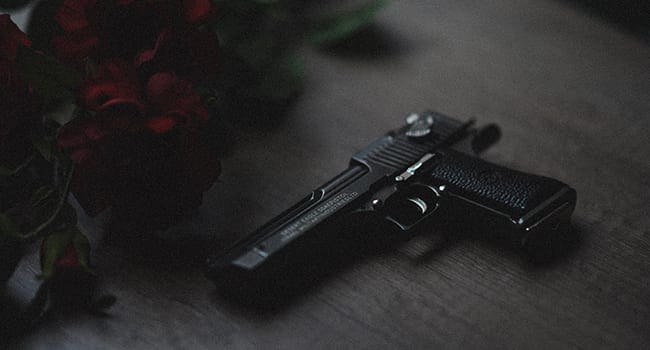 An analysis by the CBC covering two decades of homicide statistics for Winnipeg reveals a major shift in the types of weapons used. It’s happening across the country.
An analysis by the CBC covering two decades of homicide statistics for Winnipeg reveals a major shift in the types of weapons used. It’s happening across the country.
Winnipeg had 44 homicides in 2019, more than in any other previous 10-year period. Police seized 1,771 guns in 2018, up from 1,195 in 2017 and 825 in 2016.
Police statistics indicate that, in the last four years, crimes where a firearm was involved increased in Winnipeg from 192 in 2014 to 319 in 2018.
According to the report, nearly 40 per cent of the homicides were the result of a shooting – a notable change in a city where stabbings and physical assaults have been the leading causes of violent deaths. The shooting deaths in 2019 far surpass the 12 in 2008 – the year with the next highest number of gun-related homicides. In 2018, Winnipeg reported only three homicides that involved shootings.
Police attribute this spike in gun deaths to a “trend that has been years in the making,” related primarily to the emergence of street gangs and organized crime involved in the illicit drug trade.
Gun violence is not unique to Winnipeg, however. Toronto recorded 78 homicides in 2019, down from 93 in 2018 but up from 62 in 2017. There were at least 464 shootings in Toronto, compared to 399 in 2018 and 370 in 2017.
Of the homicides in Toronto, at least 41 involved a firearm. In 2018, 48 of the 62 homicides involved shootings and in 2017, 38 of the 51 homicides involved shootings.
What’s common to Winnipeg, Toronto and other cities across the country is that most shootings are associated with gang activity, drug trafficking and turf wars.
Police agencies across Canada report increases in gun seizures and that there’s an increasing preference for domestically stolen guns and those purchased by licensed gun owners who then sell them to people who wouldn’t be allowed to buy a gun themselves.
Even more concerning is the use of ghost guns, those manufactured illegally at home. Ghost guns are favoured by criminals because they’re untraceable.
By September of this year, Winnipeg police had seized 70 homemade guns, up from 52 in 2018, six in 2017, and three in 2016.
Ghost gun seizures have been reported across Canada, including four homemade MAC-11 submachine pistols capable of discharging 32 rounds in two seconds. You can easily find on the Internet how to build homemade firearms, including an M-16 or MAC-11.
The Ontario Provincial Police recently seized 38 homemade guns manufactured using easily obtainable unregulated parts. It’s a trend seen across the country.
Wes Winkel, president of the Canadian Sporting Arms and Ammunition Association (CSAAA), notes that making firearms at home only requires generic parts available at any hardware store: springs pins, and screws that would be virtually impossible to regulate.
This is an especially concerning trend given, as Winkel notes, “There is no way to control springs and screws. You simply can’t control every piece of metal in the world.”
According to the CSAAA, manufacturers are also devising ways of skirting regulations by designing firearms called 80 per cent guns – firearms fabricated specifically to fall outside the legal threshold for a firearm. These guns can be easily turned into fully functional firearms.
In addition to straw purchases, ghost guns, and 80 per cent guns, there’s an even more alarming prospect: the arrival of untraceable, undetectable 3D-fabricated handguns. Instructions for fabricating the Liberator plastic pistol are posted online. The weapon is untraceable and invisible to metal detectors.
The federal government committed $51.2 million for the Canada Border Services Agency over five years starting in 2018-19 to keep illegal firearms out of Canada.
The fact criminals have resorted to homemade guns may be an indication of the success of cross-border interdiction of firearm trafficking.
It may also mean that firearms traffickers have become more proficient in evading detection by resorting to the dark web – the hidden part of the Internet accessible only through proprietary software.
According to RCMP Sgt. Marie Damian, the Canadian Firearms Program has no national repository that collects information or tracks statistics with regard to the origin of crime guns. Lynn Barr-Telford, director-general in charge of justice surveys at Statistics Canada, says: “We don’t know the origin of firearms involved in gun crime in Canada.”
What we can be certain of is that there’s no shortage of firearms in Canada, that firearms are easily available to criminals, that trafficking in firearms continues to be lucrative and that criminals aren’t deterred from using firearms.
Gun buyback or amnesty programs have also been tried across the country to remove unwanted firearms from the streets.
The Manitoba gun amnesty program in June 2019, involving 13 police agencies, collected 700 firearms and 22,000 rounds of ammunition.
A similar program in Saskatchewan collected 300 firearms in 2019.
Toronto’s most recent gun buyback program, from April 26 to May 17, 2019, paid $200 for long guns and $350 for handguns. It collected more than 3,000 firearms, the most successful roundup in the police service’s history.
However, just as guns are taken out of circulation new ones seem to appear on the streets.
Even trained security officials have lost or had their firearms stolen in alarmingly significant numbers. According the RCMP, police and public agencies in Canada reported 469 handguns lost and another 117 handguns stolen between 2005 and 2019. These include 11 submachine-guns, a fully automatic C-8 and a Federal M201-Z Riot Gun.
The Department of Defence has reported 559 firearms lost by the military and another 14 stolen between 2008 and 2018.
It’s not surprising that the response from police is the call to get tough on crime.
Firearms regulations can only go so far and gang members and criminals ready to purchase and use firearms are not likely to be easily stopped or rehabilitated. Strict bail and parole enforcement, focused enforcement and zero tolerance against firearms offence are logical approaches for maintaining public safety.
The obvious responses include:
- increased uniform patrols in areas prone to gang activity and violent crimes;
- increasing focus on the enforcement of bail and parole conditions;
- enhanced undercover operations against gangs, drug trafficking, and firearms offences;
- enhancing intelligence-led initiatives through surveillance, informants, agents, and covert initiatives;
- improved community participation through intake of anonymous sources information such as CrimeStoppers;
- and greater commitment to seek stiffer sentences for offenders.
This all-out effort to control violent crimes, however, requires careful assessment of its effectiveness.
The responses now and in the past are too narrow.
In addition to enforcement, police services need to institute gang exit programs, rehabilitative and job training within corrections institutions.
Our corrections institutions have become holding facilities with few effective rehabilitative programs. They must include programs for the safe and effective reintegration of those released back into society.
Corrections facilities need to have their performances measured on recidivism rates and not solely on their capacity to manage inmates.
There must also be a proportionate increase in the support for the victims and victimized communities, and for the families of the accused. Zero-tolerance strategies could result in another generation of citizens who view the police as heavy-handed and unfair.
That means police leaders must redouble their community-based policing efforts. Community policing should not be a fair-weather strategy. It’s even more critical when officers must serve as guardians of public safety against the most violent offenders.
The solution lies in addressing the causes that drive young people on a trajectory of crime.
Anil Anand is a research associate with the Frontier Centre for Public Policy. He served as a police officer for 29 years; including as a divisional officer, undercover narcotics officer, and intelligence officer. He has also worked in professional standards, business intelligence, the Ipperwash Inquiry and with Interpol.
Anil is a Troy Media Thought Leader. Why aren’t you?
The views, opinions and positions expressed by columnists and contributors are the author’s alone. They do not inherently or expressly reflect the views, opinions and/or positions of our publication.

